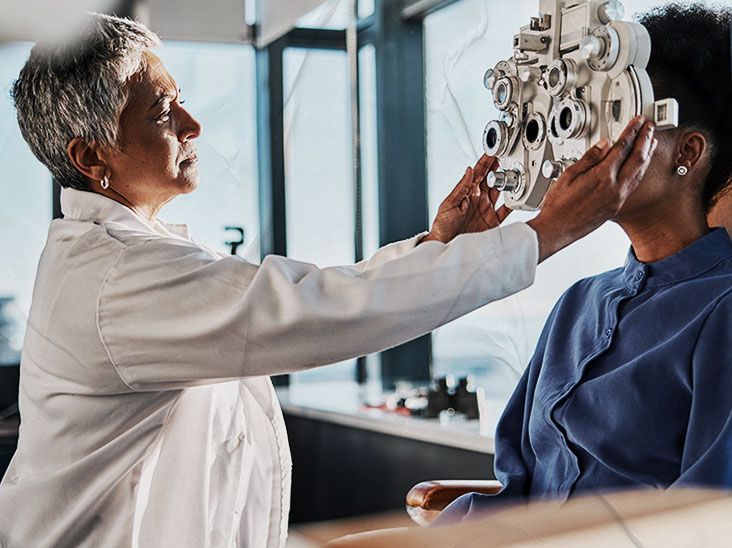Blood
Tips to prevent eye damage from diabetes
Helping prevent eye damage from diabetes involves keeping blood sugar, blood pressure, and cholesterol levels within target ranges. Regular exercise and yearly eye exams are also important.
Diabetes can harm the eyes over time and cause several conditions that may result in vision loss and blindness. However, managing diabetes can help prevent the development or progression of these conditions.
This article explores how to help prevent eye damage from diabetes. It also discusses when to seek help for eye conditions and why yearly eye exams are necessary.
People with high blood sugar have an increased risk of developing diabetic eye conditions. With time, high blood sugar can:
- harm the blood vessels in the eyes
- affect the shape of the eye lens, a transparent structure that changes shape to allow the eye to focus on objects at varying distances
- make vision blurry
The National Institute of Health (NIH) offers the following recommendations to help keep blood sugar levels within the target range:
- Test the blood regularly: An A1C test indicates a person’s average blood sugar level over the past 3 months. The A1C goal for many individuals with diabetes is below 7%. It is also best for people to check their blood sugar levels daily and keep a record of them.
- Quit smoking, if applicable: Because smoking narrows blood vessels, quitting smoking is particularly beneficial. This also reduces other risk factors for diabetes, including high blood pressure and cholesterol.
- Take prescribed medications: Even when people feel good, they should continue to take prescribed medications for diabetes and any other conditions unless a doctor advises otherwise.
Learn more about managing blood sugar levels.
Managing blood pressure and cholesterol promotes blood sugar management, which helps prevent diabetic eye damage.
The blood pressure goal for most individuals with diabetes is 140/90 millimeters of mercury. Over time, high blood sugar can harm blood vessels and lead to high blood pressure, which is an elevation in the force of blood going through the arteries.
Additionally, high levels of low-density lipoprotein — or “bad” — cholesterol may lead to plaque accumulation in the damaged walls of arteries.
A doctor may prescribe medications to keep blood pressure and cholesterol close to target levels.
Learn about how to lower cholesterol.
Eating healthily is essential for managing diabetes and reducing the risk of complications, including eye damage.
Food and beverage choices
A meal plan for diabetes may include the following:
- fruits and vegetables
- whole grains
- beans
- fish
- lean meats, such as chicken or turkey without the skin
- low fat or nonfat dairy products
People may need to choose foods that are lower in:
- sugar
- saturated and trans fats
- calories
- salt
It is also best to drink water rather than sugar-sweetened beverages.
Exercise goals
Getting regular physical activity is equally important. People can try to work up to 30 minutes of exercise on most days of the week.
While a healthy diet and regular exercise help manage blood sugar directly, they also promote weight management, which indirectly helps control blood sugar. These two lifestyle practices can promote reaching and maintaining a moderate weight.
Learn more about diabetes meal plans.
Certain symptoms indicate eye damage that needs prompt medical attention.
If a person has any of the following symptoms, they should make a doctor’s appointment as soon as possible:
- a sudden change in vision clarity
- red fog or spots in the visual field
- little black lines or spots in the visual field that do not go away
- requiring longer to adjust to darkness than usual
Usually, the sooner a doctor discovers and treats a person’s eye condition, the better the outcome.
Learn about blurry vision and diabetes.
Eye conditions are common with diabetes. Some of these, such as diabetic retinopathy, do not cause symptoms in the early stages.
Diabetic retinopathy affects blood vessels in the retina, the tissue in the back of the eye. As the condition progresses, it can cause vision loss and blindness.
This is why experts advise getting an eye exam involving pupil dilation at least once a year. Pupils are the black circles in the center of the eyes. A dilated eye exam uses drops to widen pupils, enabling a doctor to view the inside of the eye.
Once a person receives a diagnosis, treatments can begin, which may be very effective and help prevent vision loss.
Learn about what to expect during diabetic eye screening.
Preventing eye damage from diabetes involves managing aspects of health that increase the risk of this complication. This includes blood sugar, blood pressure, and cholesterol levels. Eating a healthy diet and exercising regularly can also help.
Since early eye damage may not involve symptoms, having a yearly exam is vital to identify any developing conditions before they cause vision loss. If a person notices new symptoms, such as red spots in their vision, they should contact a doctor quickly rather than waiting until their yearly eye exam.

